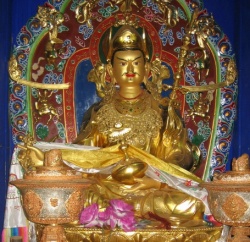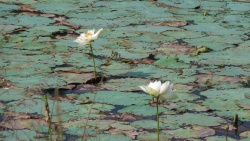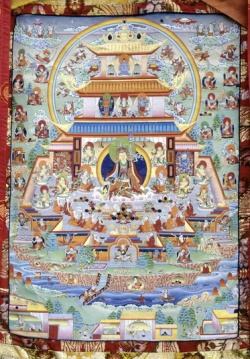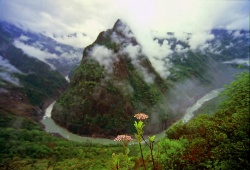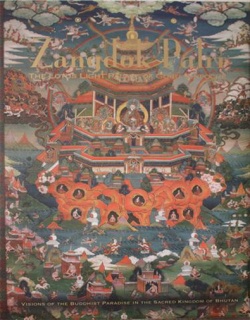Yarlung Tsangpo River
The Yarlung Tsangpo River cuts a tortuous path through the Himalayas in southeast Tibet. Where it takes a sharp turn at Mt. Namcha Barwa it forms the world's largest canyon, which reaches a depth of 5,382m (17,657 ft). In the deepest part of the canyon--an undisturbed fairyland of snow-clad peaks, glistening waterfalls, and vast virgin forests--lies Pemako. Covering an area of over 30,000 sq km (11,583 sq miles) on the border between southeast Tibet and the northeast India, it is the last county within the reaches of the Yarlung Tsangpo River in China. Of its population of nearly ten-thousand, 60% are Menpas while the rest are Luopas and Tibetans.
In Buddhism, Pemako is a synonym for 'hidden lotus-land', the place where real happiness lies in concealment. It is believed to be the earthly representation of Dorje Pagmo, a Tibetan goddess, and each mountain and river is looked on as a part of her body. It hovers in the dreams of Buddhists as a sacred place blessed by Padmasambhava, as well as an earthly paradise with an inexhaustible supply of food. Beginning in the early eighteenth century, large numbers of Menbas left the Menyu area (part of Tibet, to the south of the so-called McMahon Line) and settled in Pemako after a long journey. The latest migration, which took place in 1906, resulted from religious fervor. Over a thousand Tibetans trekked from the Chamdo Region to the fertile 'lotus-land'.
Mt. Namcha Barwa blocks cold air from the north while warm monsoons from the Indian Ocean fertilize this land with yearly moisture. It is the lowest part of Tibet, with the most humid climate and the best-preserved ecosystems. Over 3,700 kinds of plants are widely distributed and numerous animal species such as snow leopards, Bengal tigers and gibbons make their home here. Jungles, snow peaks, waterfalls and rattan bridges are its features, not to mention the spectacular Great Canyon left by the roaring Yarlung Tsangpo River. An amazing natural park, it is also the place where the local Menpas and Luopas have been living a simple life for over a hundred years, unaware of the changes taking place in the outside world. Revealed to the world by the discovery of the hidden waterfalls of the Yarlung Tsangpo River, the picturesque and mystic Pemako has been drawing more and more outsiders for exploration. However, the way to this paradise is, unfortunately, not suitable for modern vehicles. The meeting of the Great Canyon and the mountains brings not only a humid subtropical climate but frequent landslides and mudslides which make roads, a basic connection to the outside world, an unrealized dream of the locals. Pemako is the only county in China which cannot be reached by highway. Porters who make their living by conveying goods in and out are the only means of transportation, and are only available during the few months of summer. In 1994 the first automobile arrived at Pemako via a highway built from Pome County but never found its way back owing to unexpected road collapses. Treks to the mysterious lotus-land are hard and dangerous with cliffs, rains, swamps and even leeches. In fact, they are only available during August to October when the snow melts and are only for those who are fully prepared, both physically and mentally. A trek to Pemako is risky and yet irresistibly appealing as a wilderness experience that leaves life-long memories.
In Nepal and Tibet, around Mount Everest, are the Khenbalung, Khumbu, Rolwaling, Rongshar, Kyirong and Nubri sacred valleys. One of the most legendary beyul is Pemako (“the Secret Land Shaped Like a Lotus”), in southeastern Tibet, east of a dramatic Tsangpo River gorge known as the Great Bend, where the river curves sharply into the Indian state of Arunachal Pradesh. The Tsangpo Gorge is three times deeper than the Grand Canyon, with enormous waterfalls in which the river drops more than 8,000 feet in a 150-mile stretch. These waterfalls, where several explorers have lost their lives, are said to be a gateway to a secret inner part of Beyul Pemako. The Tsangpo River connects Pemako to one of Tibet’s most sacred mountains, Mount Kailash, and the landscape of the Tsangpo-Pemako area is said to represent the body of the goddess Dorje Pagmo, with the river her spine and the surrounding peaks her breasts.
The Pemako is consecrated to the female divinity of Dorje Phagmo and its sacred geography is mapped to the body of this sleeping Goddess. Her head is the Kangri Kangpo, her two breasts is Namche Barwa and Gyala Peri respectively. The lower part of her body lies in Yangsang or the innermost pemako which is the upper Siang region of Arunachal Pradesh. In the confluence of Siang (Tsangpo) and Yangsang is the sacred triangle Kila Yangzom the vulva of Goddess Dorje Phagmo. This the supreme of sacred lands is now open to the world to discover and marvel.
Every year pilgrims traverse the area on Kora (circumbulation). Covering the sacred Devakota, the gathering place of Dakinis, The holy Titapori mountain, Pemashree and Riu Tala (Eko Dumbing for Adis).
After the Chinese occupation in 1959, Dudjom Rinpoche directed his disciples in Tibet to relocate in Pema Kod, instructing them to take there important sacred objects from his Tibetan monastery. Togden Sithar, Tulku Orgyen Phuntsok's former incarnation, a highly realized champion of Buddhadharma, was entrusted by Dudjorn Rinpoche with the responsibility for the sacred objects and retreat land at what was known as the very heart of the Pema Kod region. This is the task that Tulku has inherited from his former life as Togden Sithar.
he remote location of Tulku's part of Pema Kod, just below the Tibetan border in the far northeast corner of India, protects its people with their deep respect for the sacred quality of their land.There is a tradition in Tibetan folklore of beyuls secret or hidden territories. Nyingmapas understand that Guru Rinpoche, who brought Vajrayana to Tibet in the 8th century, empowered 108 of these havens, places of peace and prosperity where practitioners will make particular spiritual progress.Pema Kod, "hidden lotus land," called the "heart of the world," and the king of Padmasambhava's hidden lands, is in effect the crown jewel of this mala of 108 beyuls This mystic land is associated with the great gorge of the Tsangpo River, the deepest in the world (4 times as far down as the Grand Canyon!) and a centuries-long quest for a falls there, the highest in Asia, helping to pour the Tsangpo into the low-lying Indian Bramaputra,. Behind such a cascade, Tibetan texts claim, lies the door to Yargsang, the ultimate hidden land of immortality, reachable only by those with purified hearts and minds.
"Bhaka Tulku had told me about a Tibetan nun whom he had met during his stay at Rinchenpung in 1956. The nun would disappear into the forests around Tapak Ne for davs at a time, Bhakha Tulku related, and return as if intoxicated, bearing fruits and flowers that no one had ever seen before. No one had followed her on her journeys, but all assumed that she was attending Tantric tsok feasts in the halcyon realms of the dakinis -- beyond conventional limits of time and space."
Padmasambhava. in the Tsa-Stim Gongdus, described this sacred land, where he meditated in many mountain caves, in a wonderful passage:
"In this hidden land, all mountains are like blooming flowers. All rivers spontaneously recite mantras and flow with nectar; rainbows are arched on trees and bushes. All the oath-bound protectors watch closely and protect true practitioners and punish those who merely pretend to be. Those who practice sincerely will attain enlightenment in this lifetime. Pure samadhi will spontaneously arise just by being in this land. One session of practice in this blessed land is equal to a year of practice in other places. Those who make three prostrations here will never take lower rebirth. Those who die after seven steps taken with the intention of arriving here will definitely be reborn in this land.. Those who build stupas and temples, and perform other works of virtue in this land are my messengers. Therefore, my fortunate sons and daughters, keep devotion to this land. You will soon realize its significance."
Though the whole of Pemako is a hidden land, there is one site in particular which Guru Rinpoche predicted as being a place where eternal youthfulness and success in religious practice could be attained, especially when Tibet would be befallen by
calamities due to the negative karma of her people. The gateway to this place is none other than DevakoIa, and Lopon P. Ogyan Tanzin Rinpoche’s work in Payingdem can be seen as a preparation to enter that most secret of secret lands.
Homage to the guru who reveals the secret pathways
To the hidden land at the centre of my heart
Where resides the eternal teacher
Beyond all birth and death
Ever serene and radiant
To you I pray:
In all my lives may we come face to face,
May my mind be always merged with yours!
May my prayers turn towards you
In times happy and sad!
May your blessings pour upon me
And your teachings be my only light!
Largely untouched by the workings of the modern world, Pema Kod (Pemako) is a rare, pristine, and little-known sacred land bordering India, Bhutan, and Tibet/China. Getting there involves a challenging week of travel, from plane, to boat, to jeep, and finally trekking for two days on foot. For this reason, little has been done to address the extreme material poverty of the region by Western standards. Few of its many small villages have schools or electricity, and virtually none have medical care.
